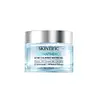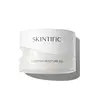What's inside
What's inside
 Key Ingredients
Key Ingredients

 Benefits
Benefits

 Concerns
Concerns

 Ingredients Side-by-side
Ingredients Side-by-side

Water
Skin ConditioningPanthenol
Skin ConditioningMethyl Gluceth-20
HumectantDipropylene Glycol
HumectantCentella Asiatica Extract
CleansingCalendula Officinalis Extract
Skin ConditioningAvena Sativa Kernel Extract
AbrasivePhaeodactylum Tricornutum Extract
HumectantChlorella Vulgaris Extract
Skin ConditioningPentylene Glycol
Skin ConditioningAcrylates/C10-30 Alkyl Acrylate Crosspolymer
Emulsion StabilisingTromethamine
Buffering1,2-Hexanediol
Skin ConditioningEctoin
Skin ConditioningCeramide NP
Skin ConditioningCeramide As
Skin ConditioningCeramide Ns
Skin ConditioningCeramide AP
Skin ConditioningCeramide EOP
Skin ConditioningButylene Glycol
HumectantGlycerophosphoinositol Choline
Skin ProtectingGlycerin
HumectantAmmonium Acryloyldimethyltaurate/Vp Copolymer
Hydrogenated Lecithin
EmulsifyingTocopherol
AntioxidantPentasodium Pentetate
Erythritol
HumectantPropanediol
SolventPhytic Acid
Silver Oxide
AntimicrobialDiethoxyethyl Succinate
SolventHydroxyphenyl Propamidobenzoic Acid
Skin ConditioningLecithin
EmollientSodium Ascorbate
AntioxidantAscorbyl Palmitate
AntioxidantWater, Panthenol, Methyl Gluceth-20, Dipropylene Glycol, Centella Asiatica Extract, Calendula Officinalis Extract, Avena Sativa Kernel Extract, Phaeodactylum Tricornutum Extract, Chlorella Vulgaris Extract, Pentylene Glycol, Acrylates/C10-30 Alkyl Acrylate Crosspolymer, Tromethamine, 1,2-Hexanediol, Ectoin, Ceramide NP, Ceramide As, Ceramide Ns, Ceramide AP, Ceramide EOP, Butylene Glycol, Glycerophosphoinositol Choline, Glycerin, Ammonium Acryloyldimethyltaurate/Vp Copolymer, Hydrogenated Lecithin, Tocopherol, Pentasodium Pentetate, Erythritol, Propanediol, Phytic Acid, Silver Oxide, Diethoxyethyl Succinate, Hydroxyphenyl Propamidobenzoic Acid, Lecithin, Sodium Ascorbate, Ascorbyl Palmitate
Water
Skin ConditioningButylene Glycol
HumectantDiethoxyethyl Succinate
SolventSqualane
EmollientCetearyl Olivate
Sorbitan Olivate
EmulsifyingDimethicone
EmollientAmmonium Acryloyldimethyltaurate/Vp Copolymer
Hydroxyacetophenone
AntioxidantCetearyl Alcohol
EmollientCoco-Caprylate/Caprate
EmollientCyanocobalamin
Skin ConditioningLactobacillus/Milk Ferment Filtrate
Skin ConditioningPentylene Glycol
Skin ConditioningAcrylates/C10-30 Alkyl Acrylate Crosspolymer
Emulsion StabilisingBisabolol
MaskingPortulaca Oleracea Extract
Skin ConditioningCeramide Ns
Skin ConditioningSodium Hyaluronate
HumectantHydroxyphenyl Propamidobenzoic Acid
Skin ConditioningCentella Asiatica Extract
CleansingAsiaticoside
AntioxidantWater, Butylene Glycol, Diethoxyethyl Succinate, Squalane, Cetearyl Olivate, Sorbitan Olivate, Dimethicone, Ammonium Acryloyldimethyltaurate/Vp Copolymer, Hydroxyacetophenone, Cetearyl Alcohol, Coco-Caprylate/Caprate, Cyanocobalamin, Lactobacillus/Milk Ferment Filtrate, Pentylene Glycol, Acrylates/C10-30 Alkyl Acrylate Crosspolymer, Bisabolol, Portulaca Oleracea Extract, Ceramide Ns, Sodium Hyaluronate, Hydroxyphenyl Propamidobenzoic Acid, Centella Asiatica Extract, Asiaticoside
 Reviews
Reviews

Ingredients Explained
These ingredients are found in both products.
Ingredients higher up in an ingredient list are typically present in a larger amount.
Acrylates/C10-30 Alkyl Acrylate Crosspolymer is a synthetic polymer. It is used to thicken and improve the texture of products. Due to its properties, it can prevent water and oil ingredients from separating.
Ammonium Acryloyldimethyltaurate/Vp Copolymer (let's call it AAVC for short) is a synthetically created polymer. It's used as a film-forming agent and used to thicken the consistency of products.
AAVC is able to increase the consistency and viscosity of products due to its large molecule size. It also prevents ingredients from separating.
Butylene Glycol (or BG) is used within cosmetic products for a few different reasons:
Overall, Butylene Glycol is a safe and well-rounded ingredient that works well with other ingredients.
Though this ingredient works well with most skin types, some people with sensitive skin may experience a reaction such as allergic rashes, closed comedones, or itchiness.
Learn more about Butylene GlycolCentella Asiatica Extract (Centella) is derived from an herb native to Southeast Asia. It is famous for its anti-inflammatory and soothing properties.
Centella is rich in antioxidants and amino acids, such as Madecassic Acid and Asiaticoside.
Studies show the compounds in centella help with:
The combination of all these properties makes centella effective at soothing, hydrating, and protecting the skin.
Other great components of centella include Vitamin A, vitamin C, several B vitamins, and Asiatic Acid.
Fun fact: Centella has been used as a medicine and in food for many centuries. As a medicine, it is used to treat burns, scratches, and wounds.
Learn more about Centella Asiatica ExtractCeramide NS is formally known as Ceramide 2. It is one of the major ceramides in the stratum corneum (outermost layer of skin) plays a role in forming a protective barrier.
Due to its structure, skin lipids can be packed tightly and in turn, this strengthens the barrier and reduces water loss.
Studies show conditions like atopic dermatitis can worsen when ceramide NS levels are low.
Learn more about Ceramide NsWe don't have a description for Diethoxyethyl Succinate yet.
We don't have a description for Hydroxyphenyl Propamidobenzoic Acid yet.
Pentylene glycol is typically used within a product to thicken it. It also adds a smooth, soft, and moisturizing feel to the product. It is naturally found in plants such as sugar beets.
The hydrophilic trait of Pentylene Glycol makes it a humectant. As a humectant, Pentylene Glycol helps draw moisture from the air to your skin. This can help keep your skin hydrated.
This property also makes Pentylene Glycol a great texture enhancer. It can also help thicken or stabilize a product.
Pentylene Glycol also acts as a mild preservative and helps to keep a product microbe-free.
Some people may experience mild eye and skin irritation from Pentylene Glycol. We always recommend speaking with a professional about using this ingredient in your routine.
Pentylene Glycol has a low molecular weight and is part of the 1,2-glycol family.
Learn more about Pentylene GlycolWater. It's the most common cosmetic ingredient of all. You'll usually see it at the top of ingredient lists, meaning that it makes up the largest part of the product.
So why is it so popular? Water most often acts as a solvent - this means that it helps dissolve other ingredients into the formulation.
You'll also recognize water as that liquid we all need to stay alive. If you see this, drink a glass of water. Stay hydrated!
Learn more about Water